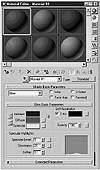| ISO 9000 | ISO 14000 |
 GMP Consulting |
Using Unwrap UVW to Change Mapping To change exactly which pixels of a bitmap correspond to which vertices of the geometry, apply an Unwrap UVW modifier. If you click the Edit button under its Parameters rollout, you will bring up the window with a representation of the vertices of your object superimposed on your bitmap. You can then move the points representing the vertices to the pixels of the bitmap you want them to display. Now that you understand the basic concepts involved in shading geometry in MAX, we’re ready to take a look at how that shading is applied through MAX’s powerful Material Editor. Mastering the Material EditorThe Material Editor (illustrated in Figure 8.1) can be considered a whole separate program from 3D Studio MAX. It is very complex and at times confusing. That is why you will learn about some of the more basic areas of the Material Editor first. In some of the previous chapters, we talked about the user interface and some of the more important tools, like the navigation tools, that you needed to know to become proficient at using MAX R3. The same thing applies to the Material Editor—you have to understand the interface and how to get around the Material Editor to get the most out of it. We will discuss the user interface and some of the more common tools that you will be using in the Material Editor.
To get started, access the Material Editor through Tools [???] Material Editor; by clicking its button on the Main Toolbar or the Rendering Tab; or by typing the M shortcut key. Moving Around in The Material Editor User InterfaceThe Material Editor is divided into specific areas. The most obvious area is the six slots represented by spheres in the top portion of the interface, the Sample Slot area. Spheres are the default sample slot shape. This area is used to preview your materials before you apply them to your objects in your scene. You use other tools in the Material Editor to make adjustments to your materials and then use the sample slots to visualize the changes. There are a few things that are common to all the sample slots, but each sample slot has its own name. The top of the Material Editor window tells you the name of the selected sample area. In this case, if you have the top-left slot selected it will say Material #1. This name can be changed in the field between the sample windows and the rollouts. To change the name of the sample slot, just highlight the word Material #1, type (for example) Red. You will notice the name on the top of the Material Editor has changed from Material #1 to Red.
You should also note that the sample area called Red has a white border around it. This border represents a selected material in the Material Editor. Just like viewports, the Material Editor can have only one active sample slot at a time. This is considered a “cool” material because even though it’s been created, it isn’t being used. A material can either be “hot” or “cool”. Whereas cool materials only exist in the Editor, hot materials are in your scene; they’ve been applied to objects.
Let’s take a look at the difference between cool and hot materials:
Let’s assign some material to an object:
Look at the two materials now. Notice that they both have small triangles in each corner of the sample slot. These are the hot materials, the ones that are assigned in your scene. You will also notice that the Wall material has a white border with the white triangles around it; that’s because the box object is selected in your scene. Select your cylinder object and notice what happens in the Material Editor. The triangles on the Wall material change from solid white to clear. The triangles tell you what object is selected in your scene. The border tells you what sample slot is selected in the Material Editor. If you look at the example in Figure 8.2, you know that the cylinder object is selected in the scene but the “box” material is the current material selected in the Material Editor. Understanding how to name, how to apply, and the difference between a cool and a hot material is a good start. Let’s continue discussing the sample slot area. You can see that you have a total of six sample slots. The Material Editor will allow up to 24 sample slots. You can, if you wish, have many, many more materials in your scene, but you can only see 24 of them in the Material Editor at a time. Also by default the sample slots are represented by spheres. MAX R3 gives you tools to change both of these defaults. To change the number of sample slots, right-click an active sample slot and select the arrangement you want from the shortcut menu: 3×2 (the default), 5×3, or 6×4 (as illustrated in Figure 8.3).
© 2000, Frol (selection, edition, publication) |
||||||||||||||||||||||||
|
|


